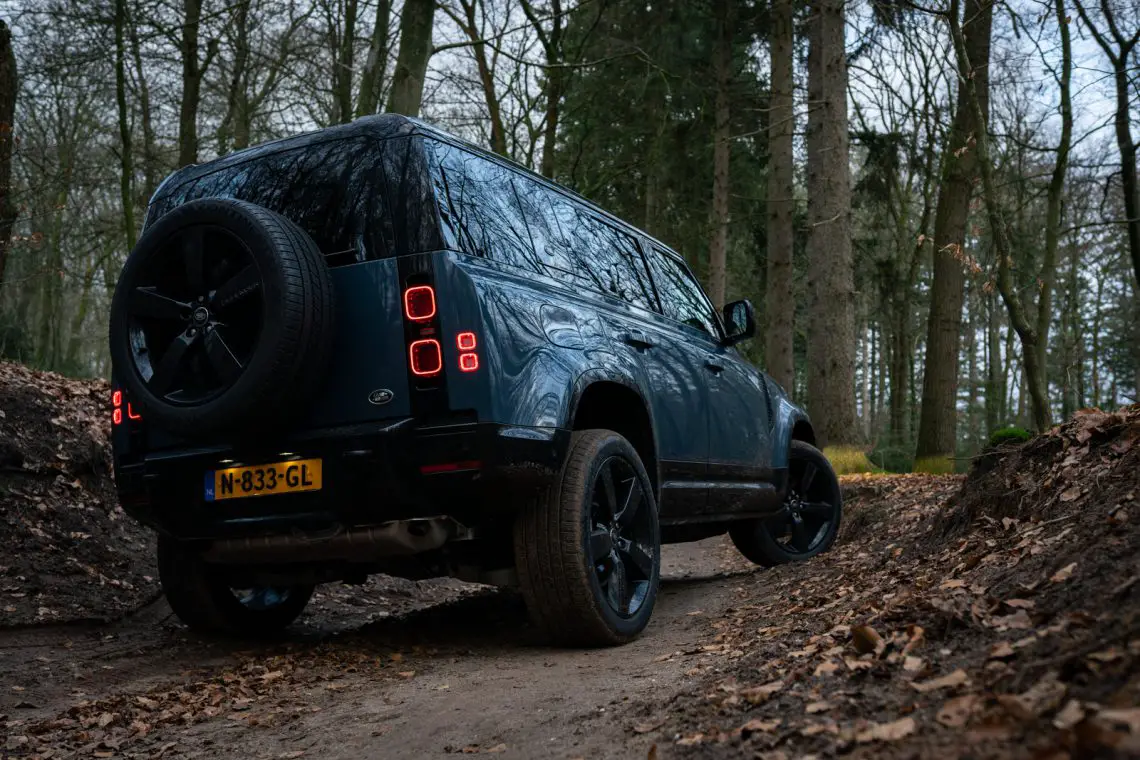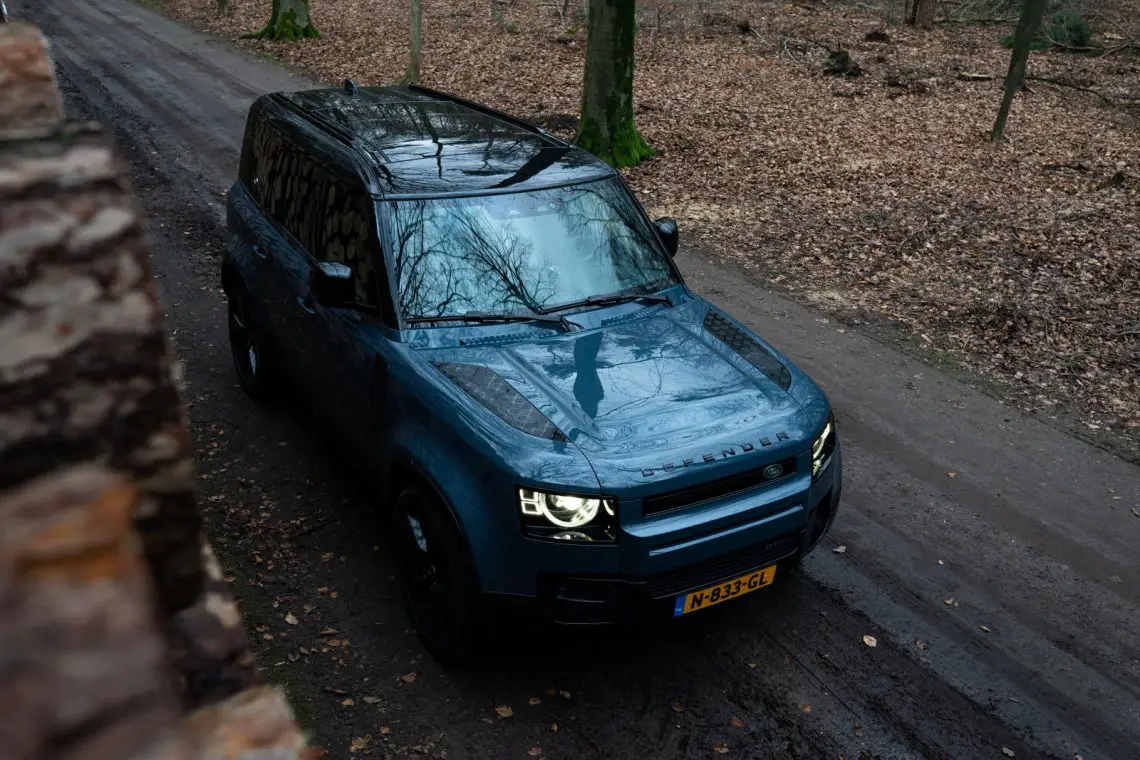CAR TEST – LAND ROVER DEFENDER 110 P400E
Piece of history with a modern twist.
The Defender holds a place in our hearts for two reasons. On the one hand because the presentation of the first Defender took place during the AutoRAI in Amsterdam and on the other because of the sympathetic appearance of the car. The Land Rover Defender is typically one of those cars that everyone likes, even if you’re not into cars. This time we go out with the Land Rover Defender P400e. A hybrid Defender, is that what?
History lesson
But before we drive the Defender P400e, let’s take a look at its history. The Defender is in fact the common thread in Land Rover’s existence. Although the name ‘Defender’ is still relatively young, its DNA goes back much further. The great-great-grandfather of this Defender was the Series I, a – for that time – serious off-roader that was slightly inspired by the Willy’s Jeep from the Second World War. However, the Land Rover was more luxurious and more focused on comfort. This Series 1 has been in production for more than ten years from 1948 and was then followed by the Series II. With some changes.
On a cosmetic level, the lines became less sharp and on the motor side it became a little more exciting, because the 50 hp 1.6-liter engine was replaced by a 2.25-liter engine with 70 hp. In the early 1970s came the Series III, a 4×4 with which you can already see a lot of similarities with our Defender. After the Series III, this type of Land Rover went through life as Land Rover with the designation of length, such as Land Rover 90 or 110. Basically it has remained the same generation until 2016. Apart from some improvements here and there and different versions, the same for over 30 years! With the addition of the name ‘Defender’ in 1990. As of 2020, the next generation Land Rover Defender will be there, our test car.
Plug-in hybrid
What a contrast between the Land Rover Series I where you can almost smell the burnt oil through your screen and our tested electrified Defender. Yes, you read that right: this Defender is not equipped with a thick V8 or diesel , but with a hybrid powertrain. So you can cover small distances completely electrically. Up to 43 kilometers (WLTP) according to Land Rover, but in practice this is slightly lower. The electric motor is powered by a 19.2 kWh battery and produces 143 hp.
For the other kilometers you have access to a 2.0-liter four-cylinder with 300 hp. The electric motor and the petrol engine together produce 404 hp. That makes Defender P400e almost the fastest, most powerful and certainly the most economical Defender ever. That mainly saves a lot of BPM, more than 40,000 euros compared to the smallest diesel engine and a sloppy 80,000 euros compared to the V8, where the performance of the P400e is almost equal. Charging the Defender P400e can be done in the places where you are used to. Fast charging is possible at a speed of 50 kW, with which you can charge the battery to 80% in 30 minutes.
fast boy
The 404 hp and 640 Nm make this Land Rover Defender P400e a fast car. It only takes 5.6 seconds from standstill to 100. That’s an impressive achievement, especially when you consider that the powertrain has to get no less than 2,669 kg forward. Shifting is done with an automatic transmission. The automatic transmission is in good working order and shifts smoothly. The transition from the electric motor to petrol is flawless and the downshifting to overtake is also the way you want it: smooth and effortless.
Bakbeest
We are on the road with the 110 version, the long variant of the Defender. The Defender 90, a three-door variant with a shorter wheelbase , is not available with this P400e drive. The Defender 110 has a length of 5 meters, including spare wheel, and is 2 meters wide and 2 meters high. In other words, a hell to park in advance. However, in practice this is not the case. The car can be maneuvered very lightly in tight parking spaces and small city streets. The Defender P400e also lends you a hand. As a driver, you get 360 degrees of Park Distance Control (optionally also as a 360° camera) around the car. You can see the obstacles on the centrally placed screen, which makes parking a breeze. In daylight, by the way, because in low light the image of the rear view camera becomes a lot less sharp and then looking around you becomes a greater challenge.
design
The angular appearance with the idiosyncratic design elements make the Defender as we know it. They have captured the feeling of the older generation Defender perfectly with the current Land Rover. Examples of these types of elements are the round headlights with characteristic separate direction indicators, the upright piece of body under the windscreen, the windows in the rounded roof, the separate rear lights and the typical curving in the flank. In our view, it is a very successful modern take on a retro design. Many people think so. People regularly give a thumbs up or they check the car when you drive by. Very nice and rightly so, because we would do it too.
The interior
We already talked about the screen that can be found in the middle of the dashboard. The PIVI Pro, as the multimedia system is called, works intuitively and responds directly to input. The positioning of the 11.4-inch screen is a bit low, so your eyes are off the road longer than you’d like. Even with the seat in the lowest position. That ‘inconvenience’ is partly solved by the Head-up Display, which you can personalize entirely to your own liking. The buttons on the steering wheel are also easy to remember, allowing you to perform simple actions without taking your eyes off the road. Furthermore, it quickly feels familiar inside the Defender 110. It’s a nice place to be. The materials are robust, yet feel premium. The large seats are regal, but because of the short seat they offer too little support for long journeys and in sharp bends they have too little lateral support. But hey, it’s not a sports car. So we can live with that.
In the back
The rear passengers have plenty of space. They also have their own climate control in the back and there are plenty of USB ports available to charge everything on the go. The trunk looks small for a five-meter car. This is mainly due to the battery pack that lies underneath. But if you fill the trunk, a lot goes in. You can also lay the back seat flat, which means you more than double the volume. The rear of the second row of seats is covered with the same material as the floor of the luggage compartment, so that they do not get damaged when you put luggage on them. That has been thought about.
You can even stack everything you want to take with you to the roof and still have a perfect view to the rear, thanks to the real-time camera images from behind the car shown on the interior mirror. In the trunk, the height of the car can be changed by means of the air suspension to make loading easier. The same air suspension also lowers the car when you get out. Useful!
The driving
Then it’s finally time to get behind the wheel of the Land Rover Defender 110 P400e and start driving. The high seat means that you look out like a king over the other traffic that – literally – looks up at you. What immediately stands out during the first few meters is the ease with which this Defender moves from place to place. It’s impressive. The colossus also continues to accelerate very easily to speeds where you know what time it is when you get a stop sign.
or it is noticeable that you are on the road with a wattle of a car. This is partly due to the wind noise that occurs early on. The fact that the car, including passengers, is carrying almost three tons of kilograms ensures that the weight is clearly felt. You feel the weight shift from the front to the rear when accelerating and vice versa when decelerating. Even after the abrupt cessation of hard acceleration, the Defender is still looking for where to put its weight, resulting in a slight wobble of the car. It also disappears just as quickly. Long swings, on the other hand, does the Defender excellent for its size, but roundabouts and tight corners at speed are not for this car.
Logically, that’s not what it was made for. The car does not invite you to constantly step on the gas, but more to switch on cruise control just above the maximum speed and then disconnect the caravan somewhere in southern Spain – because you can tow 3,000 kg – and the next day discover the off-road trails of the Pyrenees with the Defender.
Off road
Well off-road… We don’t expect many Dutch Defender buyers to go off-road with their Land Rover, but it’s nice to know that it can do it. Land Rover wouldn’t be Land Rover if you couldn’t choose from different modes for different surfaces, such as rocks, mud, snow or sand. The Defender then determines the correct ride height, gearing and which differentials should be locked for the type of surface you are riding on. You can always override these settings if you think you know better.

Three riding modes
Speaking of settings. The Defender has three different driving modes. An ‘EV mode’ in which the car drives as electrically as possible. In ‘Hybrid mode’, the Defender uses both the electric motor and the petrol engine. The latter is the ‘Save’ mode, in which only the petrol engine goes to work, so that you still have electrical capacity left over for use in the city, for example.
Prices and equipment Defender 110 P400e
Prices for the Defender start at 85,000 euros and then you immediately have the hybrid P400e drive. The Land Rover Defender P400e as we drove it costs 115,047 euros. It features the Defender X-Dynamic SE package, which includes 20-inch alloy wheels, LED headlights, interior lighting, heated door mirrors, upgraded audio system, PIVI Pro and Blind Spot assist. There are also options such as Tasman blue color, camera as rear-view mirror, WiFi, wireless phone charger, panoramic glass roof with sliding/tilting part, tow bar and 230V connection.
You can go as crazy as you want in terms of equipment at Land Rover. From roof tents to a snorkel, dog ramp, rinse system, built-in air compressor, waterproof seat covers, ladders, bicycle carriers, a winch. Everything is possible. The biggest competitor of this Land Rover Defender P400e is the Jeep Wrangler 4Xe Rubicon .
Conclusion
Returning to the question from the intro: is it something, a hybrid Land Rover? Absolute! While the P400e may only be there to bring down Land Rover’s average emissions, this is the powertrain we’d choose. The Defender with the V8 in the front is of course a desirable car, but costs two and a half times as much as the P400e and is only 0.2 seconds faster in a sprint from zero to 100 km/h. Not to mention the consumption. The P400e is fast, relatively economical and offers all the luxury and versatility you could wish for. Without having to compromise on performance or usability and you still have money left to dress things up nicely.

